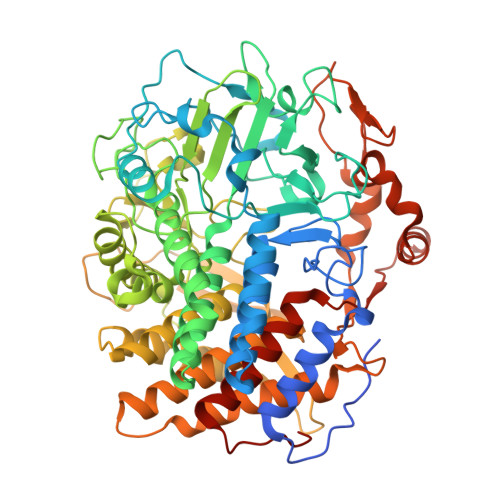The crystal structure and catalytic mechanism of cellobiohydrolase CelS, the major enzymatic component of the Clostridium thermocellum Cellulosome.
Guimaraes, B.G., Souchon, H., Lytle, B.L., David Wu, J.H., Alzari, P.M.(2002) J Mol Biol 320: 587-596
- PubMed: 12096911
- DOI: https://doi.org/10.1016/s0022-2836(02)00497-7
- Primary Citation of Related Structures:
1L2A - PubMed Abstract:
Cellobiohydrolase CelS plays an important role in the cellulosome, an active cellulase system produced by the thermophilic anaerobe Clostridium thermocellum. The structures of the catalytic domain of CelS in complex with substrate (cellohexaose) and product (cellobiose) were determined at 2.5 and 2.4 A resolution, respectively. The protein folds into an (alpha/alpha)(6) barrel with a tunnel-shaped substrate-binding region. The conformation of the loops defining the tunnel is intrinsically stable in the absence of substrate, suggesting a model to account for the processive mode of action of family 48 cellobiohydrolases. Structural comparisons with other (alpha/alpha)(6) barrel glycosidases indicate that CelS and endoglucanase CelA, a sequence-unrelated family 8 glycosidase with a groove-shaped substrate-binding region, use the same catalytic machinery to hydrolyze the glycosidic linkage, despite a low sequence similarity and a different endo/exo mode of action. A remarkable feature of the mechanism is the absence, from CelS, of a carboxylic group acting as the base catalyst. The nearly identical arrangement of substrate and functionally important residues in the two active sites strongly suggests an evolutionary relationship between the cellobiohydrolase and endoglucanase families, which can therefore be classified into a new clan of glycoside hydrolases.
Organizational Affiliation:
Unité de Biochimie Structurale, CNRS URA 2185, Institut Pasteur, 25 rue du Dr. Roux, 75724 Paris cedex 15, France.


















